Genetic Based Approach for Optimal Power and Channel Allocation to Enhance D2D Underlaied Cellular Network Capacity in 5G
Ahmed.A.Rosas,Mona Shokair and M.I.Dessouky
Department of Electronics and Electrical Communication Engineering,Faculty of Electronic Engineering,Menoufia University,Menouf,32952,Egypt
Abstract: With the obvious throughput shortage in traditional cellular radio networks,Device-to-Device(D2D)communications has gained a lot of attention to improve the utilization,capacity and channel performance of nextgeneration networks.In this paper,we study a joint consideration of power and channel allocation based on genetic algorithm as a promising direction to expand the overall network capacity for D2D underlaied cellular networks.The genetic based algorithm targets allocating more suitable channels to D2D users and finding the optimal transmit powers for all D2D links and cellular users efficiently,aiming to maximize the overall system throughput of D2D underlaied cellular network with minimum interference level,while satisfying the required quality of service QoS of each user.The simulation results show that our proposed approach has an advantage in terms of maximizing the overall system utilization than fixed,random,BAT algorithm (BA) and Particle Swarm Optimization(PSO)based power allocation schemes.
Keywords: 5G;D2D communication;spectrum allocation;power allocation;genetic algorithm optimization;BAT-optimization;particle swarm optimization
1 Introduction
In recent years,mobile communication has become an essential tool for our lives.During these years,the global mobile traffic has been increased because of the rapid increase in the demand on new cellular systems,services and applications like multimedia,virtual reality,and Internet of Things(IOT) connected devices [1].In accordance with that,the major target of the fifth-generation 5G technologies is to support such these services with huge data rate demands[2,3].To serviceable these demands,5G wireless communications are strictly faced with more stringent requirements in terms of the radio propagation environment,transmission rate,energy savings,reliability and latency.Despite this,mobile networks are still infrastructure-dependent,where each user data connection is limited to the Base Station(BS)coverage and capacity,and does not allowed to direct communication with the other devices.Especially in the case when the communication devices are in the same cell and the source close proximity to receiver.Due to this inability,a lot of technologies are under studies,where D2D communication exhibits a great potential in the way of exchange information and be a promising technology that allows cellular devices to communicate with one another directly without BS [4,5].Strictly speaking,D2D communication fundamentally must be capable of exchanging data on-demand over network bypassing the network core in order to be able to improve spectrum utilization,energy efficiency,fairness,coverage,delay and the overall network capacity with minimum transmission traffic load from BS.
In fact,one of the main critical issues in D2D communication system is resource sharing include energy and spectrum efficiencies improvement and interference reduction between D2D and cellular communication.Different prototypes of spectral utilization are introduced by many researchers to find a method to enhance spectrum utilization and reduce undesirable interferences aiming to improve the overall network performance.D2D communication is further classified based on spectral utilization into inband and outband D2D communication[6].Outband D2D communication occurs in the unlicensed spectrum with more device hardware compatibility needed.In inband D2D communication,the licensed spectrum of cellular networks shared efficiency between D2D and cellular users(CUs)[7].In inband D2D connection the resource sharing mechanism is classified into underlay and overlay[8].The D2D users in underlay D2D communication share the same spectrum resources with the CUs.But,in the overlay D2D communication,the D2D users are allocated defined resources,where the available spectrum is divided between cellular and D2D communication.Based on underlay D2D communication strategy,the D2D pairs share the allocated channels to CUs aiming to efficiently maximize the available spectrum utilization.However,the coexistence of D2D pairs and CUs in the same spectrum bands can improve spectral efficiency but leads to interference issue[9].
There are many challenges that should be considered in order to successfully start with underlay D2D communication technology related to resource allocation and interference management between D2D pairs and cellular users,which can degrade the overall network performance.Accordingly,a study should be introduced to obtain a deeper understanding of the D2D communication system and to develop a D2D scheme with optimal power allocation and efficient spectrum utilization.This scheme aims to have the potential to improve overall network capacity and interference reduction.For this reason,many research efforts in this topic have been carefully executed to manage the interference in D2D underlay communication [9].In [10],the sum rate maximization technique was studied without ensuring the QoS constraints and that’s unfair to those CUs that allow a D2D to underlay the spectrum.Then,the interference control problem aiming to maximizing the overall network throughput under pre-requisite Signal Interference and Noise Ratio (SINR) constraint algorithm formulated in [11,12].Considering interference constraint [13],this work illustrates the resource allocation problem for D2D underlaying communications in rayleigh fading channels to enhance ergodic rates under power and outage performance constraints.The authors of[14,15]illustrated that outage performance can be improved with introducing the cooperation between D2D connections and cellular network.In QoS-sensitive works,there are a lot of strategies on power control and resource allocation[16,17]in D2D underlay networks.
Many research studies,are proposed on power allocation techniques for D2D undelaying cellular networks.In[18],a simple power allocation technique based on game theory was proposed assuming that only one uplink channel resource shared with a D2D pair.Using a fixed power for cellular user CU and considered only the interference level from D2D transmitter on the CU receiver however neglected the interference on D2D receiver.The authors also introduced both centralized and distributed power allocation techniques.In[19]a power allocation based on a mode selection scheme was illustrated to ensure the minimum QoS of both the CUs and D2D links.In[20],dynamic power control mechanism are introduced for D2D underlay cellular network for interference coordination aiming to minimize the interference of CUs who effect on the performance of D2D links.In [21],the authors proposed an optimal power allocation algorithm constrained to minimum QoS requirements.The proposed scheme is based on PSO-based optimization and effectively improved the total throughput for CUs and D2D users.The authors of [22],proposed an interference minimizing scheme based on BATalgorithm for optimally power allocation for D2D underlay cellular networks.While these works reveal the sensational potential of integrating D2D communications into cellular networks,the problem of effective interference management and channel resource allocation cannot be fully utilized under the QoS constraints and is still open for research.
In this paper,to exploit the benefits of integrating in inband D2D underlay communications into cellular networks,a joint optimally power control and channel allocation algorithm is proposed.The proposed power and channel allocation scheme based on genetic algorithm GA [23].To ensure the QoS requirements necessary for cellular and D2D services,minimum outage constraints are specified for both the D2D and cellular links.Also,the proposed algorithm supports many D2D pairs that can share the same cellular channel.Hence,the interference between D2D links sharing the same channel resource is considered and also considering the interference between D2D links and cellular communication.Reasonable power and channel allocation algorithm can efficiently manage the interferences and maximize the overall network throughput while ensuring minimum rate requirement for all D2D links and CUs.
The rest of this paper is organized as follows:In Section 2,the system model and the throughput expression for D2D underlaied cellular network are illustrated.In Section 3,the formulation for the proposed approach is presented.The jointly optimal power and channel allocation approaches are discussed in Section 4.Simulation and numerical results are discussed in Section 5.Finally,conclusions are drawn in Section 6.
2 System Model
We proposed an example of in band D2D underlaying cellular networks with a centralized base station that can serves N CUs with perfect channel state information and also have k D2D pairs sharing the same cellular user bands as in Fig.1.Let the D2D links and CUs be donated as{DD1,DD2,DD3,DD4...DDj...DDK}and{Cu1,Cu2,Cu3,...Cui...CuN}.For our communication scenario,more than one D2D pair can share the same channel of cellular user but each one of D2D pairs is allowed to share only one uplink channel for cellular device.
The throughput of any cellular network can be defined based on the Shannon’s capacity model as:
The dark gallery seemed darker than ever as he turned away, but he went back to the kitchen and inquired who slept in the room at the end of the passage. The scullery maid, they told him, whom everybody laughed at, and called ‘Donkey Skin;’ and though he perceived there was some strange mystery about this, he saw quite clearly there was nothing to be gained by asking any more questions. So he rode back to the palace, his head filled with the vision he had seen through the keyhole.

whereγand B are defined as signal to interference and noise ratio SINR and channel band width.We can define The SINR for uplink channel between of the ith cellular user and base station as
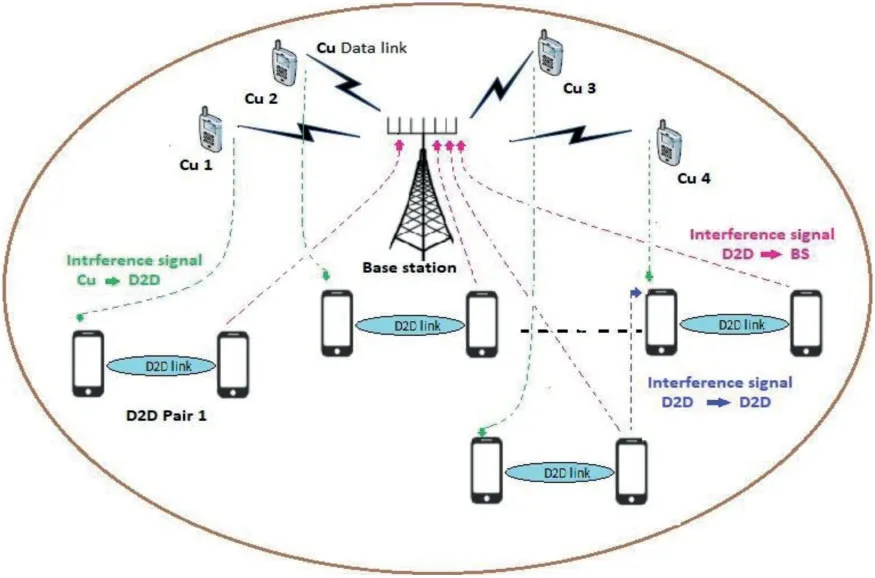
Figure 1:System model

where pcuiand pDjare the transmit power allocated to CU i and D2D pair j.And thegcuiand gDj,BSare defined as the channel power gain between ith cellular user and BS and the channel gain between jth D2D pair transmitter and BS,respectively.The activity of the D2D link can be determined by the resource sharing indicatorθjand equal 1 if D2D j share the spectrum band of cellular user i.We assumed perfect channel state information withN02Additive White Gaussian Noise(AWGN)power spectral density.So,the throughput of the ith cellular user formulated as

Similarly,The SINR of the jth D2D link determined as

wheregDj,gcui,DjandgDj,Dlare donated as the channel gain between jth D2D pair transmitter and receiver,channel power gain between ith cellular user and jth D2D pair receiver and the channel gain between the transmitter oflth D2D pair who shares the same channel and jth D2D pair receiver.pDlDonates the transmit power allocated tolth D2D link who shares the same channel with jth D2D link.Also,θjandδlare the resource sharing indicators for the activity of cellular user ith and D2D pairlth,respectively.Then,the throughput for the jth D2D link can be written as

Then the overall system throughput for all users(cellular and D2D)can be derived as

3 Problem Formulation
Now,let us focus on how to drive a mathematical formulation for our approach.The proposed scheme is classified as joint consideration of optimal power allocation to maximize the overall network capacity and path selection for each D2D link with minimum interference level and ensuring the recommended QoS for all users in the network,which can be written as
3.1 Maximizing Total Network Throughput

For all user where(i=1,2,3,...N)and(j=1,2,3,...K)
We are trying to maximize the total throughput for all D2D and cellular users in this model,Eq.(7),subject to multiple constraints.Firstly,in Eqs.(8),(9)the transmit power allocated for cellular users and D2D pairs must be limited topcumaxandpDmax,the maximum allowable power for cellular user and D2D link,sequentially.Secondly,in Eqs.(10),(11)the achievable rate for the cellular user and D2D pair must be exceeded the minimum acceptable rate or minimum QoS requirements for cellular userRcu,QoSand for D2D linkRD,QoSrespectively.Finally the interference level at the cellular user must not exceeded the interference threshold levelIThcuito ensure the required QoS.
3.2 Optimal Channel Selecting for D2D Links with Minimum Interference
In this section,we are trying to maximize the distance between cellular and D2D users Max(dcuidDj)and between D2D users Max(dDj-dDl)who share the same band as in the example shown in Fig.2.Then,we aim to minimize the interference levels between cellular user and D2D linkgcui,DjandgDj,BSand between D2D link and the othersgDj,Dlon all channels and select the optimal number of D2D links(M)who share the same cellular user spectrum where(M=M1,M2,M3,...MN).
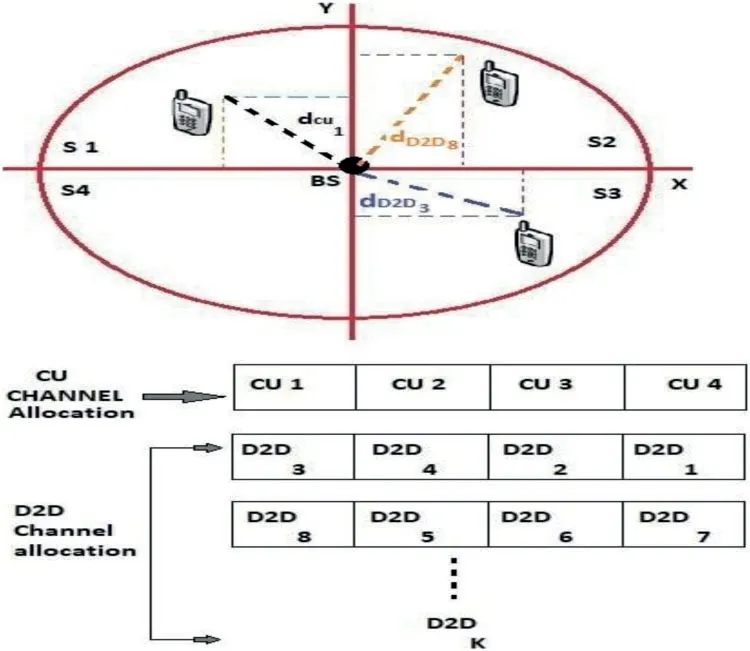
Figure 2:Channel allocation for D2D link
4 Joint Optimal Power and Channel Allocation Algorithm
Genetic based algorithm is adaptive and artificial heuristic search technique.So,genetic algorithm is proposed as intelligent optimization technique aiming to maximize the total throughput for all cellular and D2D users in this model.Our optimization problem can be solved in two steps as shown in Fig.3.
4.1 Optimal Power Allocation
In this part,the genetic algorithm allocates the optimum power level for each user seeking to maximize the total throughput with minimum interference level to achieve the required QoS for all users as in Fig.3.Firstly,the population of individuals or chromosomes are maintained within the power limitation Eqs.(8)and(9).Each individual represents a randomly candidate solutions(gens)in search space of the power level for all users.Each individual is a finite length vector of gens equal to the total number of CUs and D2D links.The initial fitness or initial throughput is evaluated for each chromosome and a score is given to each chromosome,which shows the ability to have optimal or near optimal fitness score.Chromosomes with best solutions are selected.Then,the genes at these crossover sites are exchanged thus creating a completely new and better chromosomes(offspring)by combining chromosomes of parents.Also,mutation insert random genes in the new chromosomes to maintain the diversity in the new generation and avoid being exhausted.Each new generation has more“better genes”than the previous one.Thus each new generation become better and close to the optimal than previous generations.

Figure 3:Proposed algorithm flowchart
Once the new generations don’t having any significant difference than the previous populations,the population is ended.Now the algorithm generates a set of optimal power levels for all users in this system that achieve maximum throughput.
4.2 Channel Selection
In the second part of the proposed algorithm Fig.3,we looking for optimal shared channel selection for all D2D links and also the total number of D2D links sharing the same band as in the example shown in Fig.2.Firstly,we started with the locations for all users in this model and the channels conditions.Then we determine the active CUs and D2D pairs to state if only one D2D pair allocate the channel or share the channel with CU or more than D2D link share the same channel with the activity of CU.
Then,we start to calculate the interference levels for each CU and D2D link over all the available channel which mean that the interference level is stated for each D2D link over all available cellular channels and also stated if another D2D link share the same channel with the activity of CU.The interference levels means the interference between CU link and D2D link using the same spectrum and between D2D link and another one sharing the same channel.Then the algorithm generates a set of optimal channel selections with minimum interference levels for all D2D pairs and also for each channel this algorithm assigns the optimal number of D2D links M that can share this spectrum band to fulfil the required QoS for all users.
5 Simulation Results
In this section,we tried to exploit the benefits of using the genetic based approach for optimal power and channel allocation,aiming to enhance the inband D2D underlaied cellular network capacity in 5G.And also we have compared our genetic based optimization scheme with different power allocation strategies like the random power,fixed power,PSO illustrated in[21]and BAT-optimization[22].
The channel power gain g between any transmitter and receiver for both CUs and D2D links can be identified based ond-α|h|2,where h is fading coefficient parameters,d is the distance between the transmitter and receiver,andαis the path-loss exponent[22].Random based power allocation means that the transmit power assigned to each user is selected randomly for all CUs and D2D links,and the power value is in range between the maximum and minimum power constraints value.But,the fixed power algorithm assigns a fixed transmit power value to each user in the system.All CUs and D2D Pairs are co-existing in the same region and Tab.1,shows the recommended simulation parameters that are considered in the simulation.
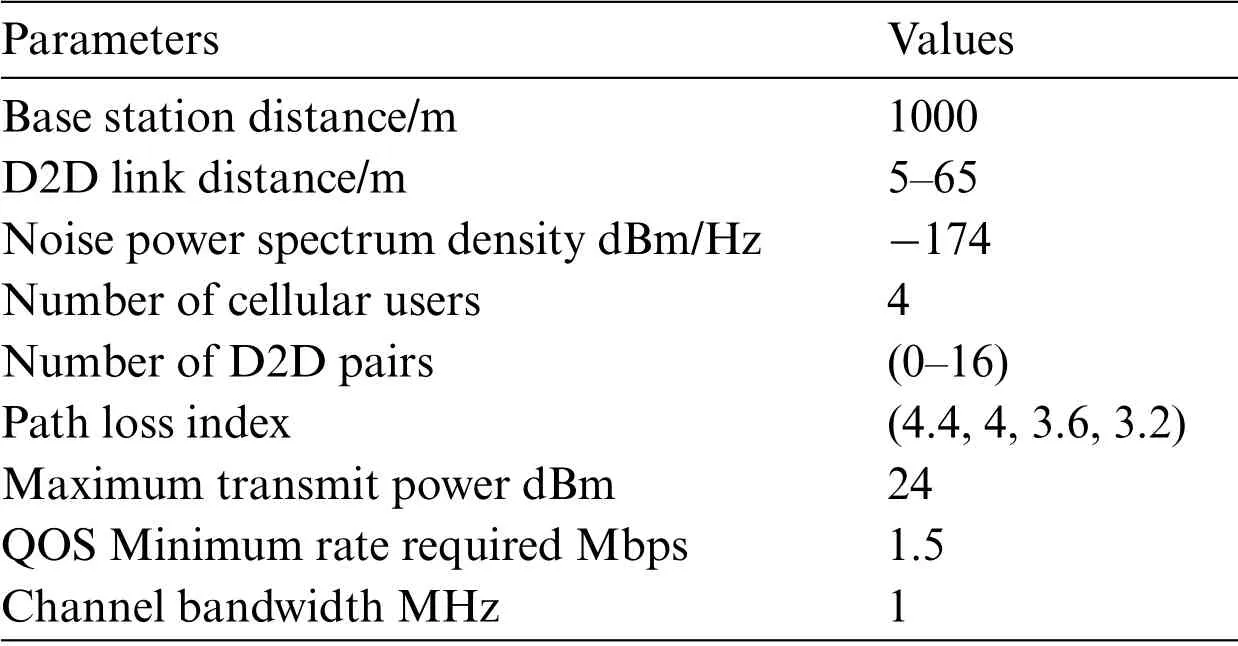
Table 1:Simulation parameters
Fig.4 shows the relation between the total network throughput and the number of D2D pairs when path loss exponent equal 4.For only existing cellular users without any D2D link,CUs send data signals with the maximum power available and the CUs throughput reaches to 82.87 Mbps.Therefore,introducing of D2D connections in cellular network can improve the total network throughput.In Addition,we can see that by increasing the number of D2D users,the total throughput for all D2D pairs and CUs is also increased.Also this shows that,GA based power and channel allocation algorithm can minimize interference and enhance the throughput of network more effectively.
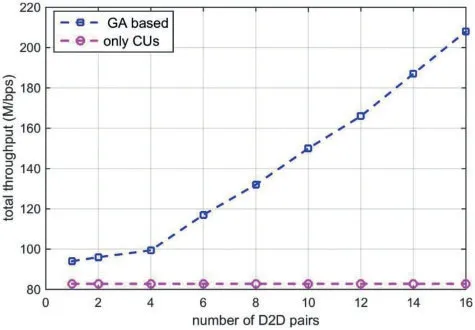
Figure 4:Total network throughput varies with the number of D2D pairs
Fig.5 illustrates network throughput of GA based power and channel allocation algorithm with different path loss exponent values.It can be seen that network throughput increases as path loss exponent increases.Because the value of path loss index is inversely proportional to the path loss effect on signal d-α.The greater path index,the smaller path loss effect,and then the receiver signal will be better.So The SINR value of signal will be improved and network throughput will be enhanced.

Figure 5:Total network throughput varies with different path loss index α
Fig.6 shows total network throughput curvevs.with the Number of D2D pairs under five power allocation Techniques.In this simulation,we compared our GA proposed scheme with BAT based,PSO based,fixed power allocation and random based power allocation techniques.The curve result shows the total throughput of the five power allocation algorithms are improved.However,GA based power and channel allocation algorithm has higher network throughput than the other four algorithms.Therefore,the introduction of D2D communication with cellular networks and using optimally power and channel allocation technique based on GA can improve the performance of network effectively in terms of total throughput and interferences reduction.So,we can see that by increasing the number of D2D users,the total throughput for all D2D pairs and CUs is also increased.Also from this figure we shows that,by increasing the total number of D2D links reached to 12,the total network throughput will be doubled than CUs only and the technique based on GA enhanced the total throughput with 7%than BAT algorithm and with 15%than PSO technique.

Figure 6:Total network throughput for 5 different algorithms with the number of D2D links
Fig.7 shows network throughput of different power allocation algorithms varies with the distance between D2D transmitter and receiver link with k=10.
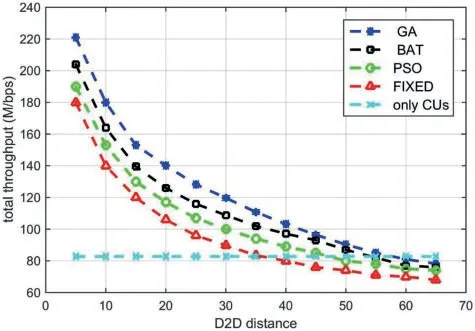
Figure 7:Total network throughput varies with D2D link distance
The network throughput for all algorithms decreases with the increase the distance d between D2D pairs.The network throughput is 82.87 Mbps when there are only cellular users.So the distance between D2D pairs must be limited and not large.For the GA based algorithm when d is greater than 59 m,network throughput is less than the total throughput for CUs only 82.87 Mbps,for BAT based algorithm d is greater than 53 m,for PSO based power allocation algorithm d is greater than 46 m,and finally for fixed power based algorithm d is greater than 36 m.This time,increasing of D2D pairs distance generate a rapid performance degradation for both cellular and D2D systems.Therefore,GA based power and channel allocation technique has better performance in increase the D2D pair distance,interference reduction and the total network throughput than the other compered algorithms.
6 Conclusion
In this paper,based on a GA optimization,the transmit power and the shared channel of each user is allocated efficiently to limit interference and maximize the overall network throughput while ensuring the minimum rate of each user to satisfy the recommended QoS.This work exploit the benefits of integrating D2D underlaying communication into cellular network to improve the total network throughput.Therefore,GA based optimization algorithm has better performance than BAT,PSO,fixed and random based power allocation algorithms which produce higher throughput and increase D2D pair distance than the others.In the future,we trying to extend this work to study how to increase the space distance between D2D pairs and the case of practical channels with perfect and imperfect CSI.
Funding Statement:The authors received no specific funding for this study.
Conflicts of Interest:The authors declare that they have no conflicts of interest to report regarding the present study.
 Computers Materials&Continua2022年8期
Computers Materials&Continua2022年8期
- Computers Materials&Continua的其它文章
- EACR-LEACH:Energy-Aware Cluster-based Routing Protocol for WSN Based IoT
- Medical Image Analysis Using Deep Learning and Distribution Pattern Matching Algorithm
- Fuzzy MCDM Model for Selection of Infectious Waste Management Contractors
- An Efficient Scheme for Data Pattern Matching in IoT Networks
- Feedline Separation for Independent Control of Simultaneously Different Tx/Rx Radiation Patterns
- Deep-piRNA:Bi-Layered Prediction Model for PIWI-Interacting RNA Using Discriminative Features
